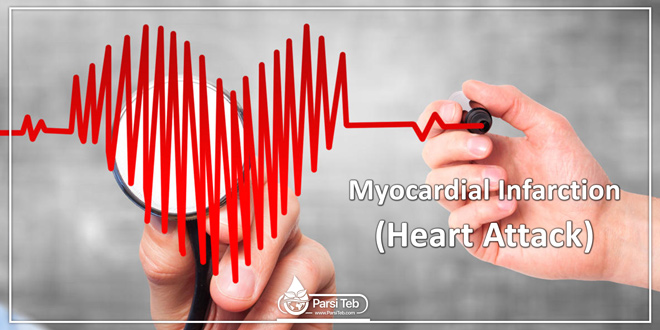Myocardial Infarction (Heart Attack)
Myocardial infarction (MI) is usually caused by a blood clot that stops blood flow in a heart (coronary) artery. You should call for an ambulance immediately if you develop severe chest pain. Treatment with a ‘clot busting’ drug or an emergency procedure to restore the blood flow through the blocked artery are usually done as soon as possible to prevent damage to your heart muscle. Other treatments help to ease the pain and prevent complications. Reducing risk factors can help to prevent an MI.
What is a myocardial infarction?
Myocardial infarction (MI) means that part of the heart muscle suddenly loses its blood supply. Without prompt treatment, this can lead to damage to the affected part of the heart. An MI is sometimes called a heart attack or a coronary thrombosis. An MI is part of a range or disorders called acute coronary syndromes. There is a brief explanation of the term ‘acute coronary syndrome’ at the end of this leaflet.
There are different types of MI which are based on what is seen on your ECG (heart tracing). The two main types are called ST elevation MI (STEMI) and non-ST elevation MI (NSTEMI). Your treatment will depend upon the type of MI you have.
Understanding the heart and coronary arteries
The heart is mainly made of special muscle. The heart pumps blood into arteries (blood vessels) which take the blood to every part of the body. Like any other muscle, the heart muscle needs a good blood supply. The coronary arteries take blood to the heart muscle. The main coronary arteries branch off from the aorta. (The aorta is the large artery which takes oxygen-rich blood from the heart chambers to the body.) The main coronary arteries divide into smaller branches which take blood to all parts of the heart muscle.
What happens when you have a myocardial infarction?
If you have an MI, a coronary artery or one of its smaller branches is suddenly blocked. The part of the heart muscle supplied by this artery loses its blood (and oxygen) supply. This part of the heart muscle is at risk of dying unless the blockage is quickly undone. (The word infarction means death of some tissue due to a blocked artery which stops blood from getting past.)
If one of the main coronary arteries is blocked, a large part of the heart muscle is affected. If a smaller branch artery is blocked, a smaller amount of heart muscle is affected. In people who survive an MI, the part of the heart muscle that dies (infarcts) is replaced by scar tissue over the next few weeks.
In a STEMI, the artery supplying an area of the heart muscle is completely blocked. However, in a NSTEMI, the artery is only partly blocked, so only part of the heart muscle being supplied by the affected artery is affected.
What causes myocardial infarction?
Blood clot (thrombosis) – the cause in most cases
The common cause of an MI is a blood clot (thrombosis) that forms inside a coronary artery, or one of its branches. This blocks the blood flow to a part of the heart.
Blood clots do not usually form in normal arteries. However, a clot may form if there is some atheroma within the lining of the artery. Atheroma is like fatty patches or plaques that develop within the inside lining of arteries. (This is similar to water pipes that get furred up.) Plaques of atheroma may gradually form over a number of years in one or more places in the coronary arteries. Each plaque has an outer firm shell with a soft inner fatty core.
What happens is that a crack develops in the outer shell of the atheroma plaque. This is called plaque rupture. This exposes the softer inner core of the plaque to blood. This can trigger the clotting mechanism in the blood to form a blood clot. Therefore, a build up of atheroma is the root problem that leads to most cases of MI. (The diagram below shows four patches of atheroma as an example. However, atheroma may develop in any section of the coronary arteries.)
Treatment with ‘clot busting’ drugs or a procedure called angioplasty (see below) can break up the clot and restore blood flow through the artery. If treatment is given quickly enough this prevents damage to the heart muscle, or limits the extent of the damage.
Uncommon causes
Various other uncommon conditions can block a coronary artery and cause an MI. For example: inflammation of the coronary arteries (rare); a stab wound to the heart; a blood clot forming elsewhere in the body (for example, in a heart chamber) and travelling to a coronary artery where it gets stuck; taking cocaine which can cause a coronary artery to go into spasm; complications from heart surgery and some other rare heart problems. These are not dealt with further in this leaflet.
The rest of this leaflet deals only with the common cause – thrombosis over an atheroma plaque.
Who is at risk of having a myocardial infarction?
MI is common. About 146,000 people in the UK have an MI each year. Most MIs occur in people over 50 and become more common with increasing age. Sometimes younger people are affected.
An MI is three times more common in young men than young women. However, after the menopause, the female hormones no longer protect the heart so the risk of having a MI is then the same for men and women.
An MI may occur in people known to have heart disease such as people with angina. It can also happen ‘out of the blue’ in people with no previous symptoms of heart disease. (Atheroma often develops without any symptoms at first.)
Certain risk factors increase the risk of more atheroma forming which can lead to an MI occurring. See separate leaflet called ‘Preventing Cardiovascular Diseases’ which discuss these in more detail.
Briefly, risk factors that can be modified and may help to prevent an MI include:
Smoking. If you smoke, you should make every effort to stop.
High blood pressure. If your blood pressure is high it can be treated.
If you are overweight, losing some weight is advised. Losing weight will reduce the amount of workload on your heart and also help to lower your blood pressure.
A high cholesterol. This should usually be treated if it is high.
Inactivity. You should aim to do some moderate physical activity on most days of the week for at least 30 minutes. For example, brisk walking, swimming, cycling, dancing, gardening, etc.
Diet. You should aim to eat a healthy diet.
Diabetes. People with diabetes have a higher risk of having an MI. This risk can be reduced by ensuring your blood pressure, cholesterol levels and glucose levels are well controlled.
Family history. Your risk is increased if there is a family history of heart disease or a stroke that occurred in your father or brother aged below 55, or in your mother or sister aged below 65.
Ethnic group. Certain ethnic groups, for example British Asians, have a higher risk of developing cardiovascular diseases.
What are the symptoms of a myocardial infarction?
The most common symptom of an MI is severe chest pain, which often feels like a heavy pressure feeling on your chest. The pain may also travel up into your jaw and down your left arm or down both arms. You may also sweat, feel sick and feel faint. You may also feel short of breath. The pain may be similar to angina, but it is usually more severe and lasts longer. (Angina usually goes off after a few minutes. MI pain usually lasts more than 15 minutes – sometimes several hours.)
However, some people have only a mild discomfort in their chest when they have an MI. The pain can sometimes feel like indigestion or heartburn.
A small MI occasionally happens without causing any pain (a ‘silent MI’). This is usually diagnosed when you have an ECG (heart tracing) at a later stage.
Some people collapse and die suddenly if they have a large or severe MI. This is not very common.
What should I do if I suspect I am having a myocardial infarction?
Call for an ambulance immediately. Then, if you have some, take one aspirin tablet (see below for the reason for this). You will normally be admitted straight to hospital.
How is a myocardial infarction diagnosed and assessed?
Many people develop chest pains that are not due to an MI. For example, you can have quite bad chest pains with heartburn, gallbladder problems or with pains from conditions of the muscles in the chest wall. However, tests can usually confirm MI. These are:
A heart tracing called an ECG (electrocardiograph). There are typical changes to the normal pattern of the heart tracing if you have an MI. Patterns that occur with an MI include things called pathological Q waves and ST elevation. However, it is possible to have a normal ECG even if you have had an MI.
Blood tests. A blood test that measures a chemical called troponin is the usual test that confirms an MI. This chemical is present in heart muscle cells. Damage to heart muscle cells releases troponin into the bloodstream. with an MI, the blood level of troponin increases within 3-12 hours from the onset of chest pain, peaks at 24-48 hours, and returns to a normal level over 5-14 days.
A rough idea as to the severity of the MI (the amount of heart muscle that is damaged) can be gauged by the degree of abnormality of the ECG and the level of troponin in the blood. Another chemical that may be measured in a blood test is called creatine kinase. This too is released from heart muscle cells during an MI.
Your heart tracing will be monitored for a few days to check on the heart rhythm. Various blood tests will be done to check on your general wellbeing.
Other tests may be done in some cases. This may be to clarify the diagnosis (if the diagnosis is not certain) or to diagnose complications such as heart failure if this is suspected. For example, an echocardiogram (an ultrasound scan of the heart) or a test called myocardial perfusion scintigraphy may be done.
Also, before discharge from hospital, you may be advised to have tests to assess the severity of atheroma in the coronary arteries. For example, an ECG taken whilst you exercise on a treadmill or bike (exercise-ECG). An angiography of the coronary arteries may also be performed. In this test a dye is injected into the coronary arteries. The dye can be seen by special X-ray equipment. This shows up the structure of the arteries (like a road map) and can show the location and severity of any atheroma.
What is the treatment for myocardial infarction?
The following is a typical situation and mentions the common treatments offered. Each case is different and treatments may vary depending on your situation. Treatments for STEMI and NSTEMI can also differ.
Aspirin and other antiplatelet drugs
As soon as possible after an MI is suspected you will be given a dose of aspirin. Aspirin reduces the ‘stickiness’ of platelets. Platelets are tiny particles in the blood that trigger the blood to clot. It is the platelets that become stuck onto a patch of atheroma inside an artery that go on to form the clot (thrombosis) of an MI.
Another antiplatelet drug called clopidogrel is also given. This works in a different way to aspirin and adds to the action of reducing platelet stickiness
Injections of heparin or a similar drug
These are usually given for a few days to help prevent further blood clots forming.
Pain relief
A strong pain killer given by injection into a vein is given to ease the pain.
Treatment to restore blood flow in the blocked coronary artery
The part of the heart muscle starved of blood does not die (infarct) immediately. If blood flow is restored within a few hours, much of the heart muscle that would have been damaged will survive. This is why an MI is a medical emergency, and treatment is given urgently. The quicker the blood flow is restored, the better the outlook.
 Parsi Teb Physical and Mental Health Journal
Parsi Teb Physical and Mental Health Journal 



